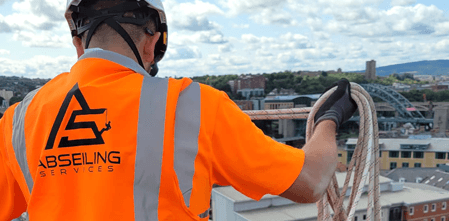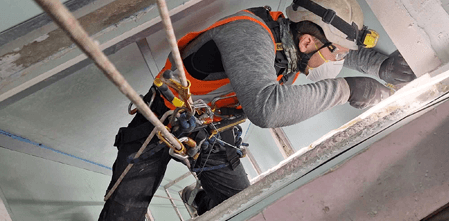Email. [email protected]
Ensuring the safety of workers operating at height is not just a regulatory requirement but a fundamental responsibility. A critical component of any fall protection system is the anchor point, the secure attachment for lifelines or lanyards. Regular inspections of these anchor points are essential to maintain compliance with safety standards and to protect workers from potential hazards.
At Abseiling Services, we are dedicated to assisting businesses in Glasgow, Edinburgh, and throughout the UK in upholding the highest safety standards through meticulous anchor point inspections. So, how often do anchor points need to be inspected? Short answer: at least once every 12 months, but that’s not the full story. Let’s dig deeper.

An anchor point inspection is a formal, documented process of assessing whether an anchor point is still safe, secure, and compliant with safety standards. It’s not a tick-box exercise, it’s a life-saving necessity. Especially in cities like Glasgow and Edinburgh, where weather and building age can increase wear and tear, regular anchor point inspection services are essential.
This process includes:
Regular inspections help identify potential issues before they become serious hazards.
Understanding your anchor point type is crucial to inspection planning.
Each type may have different anchor point inspection frequency depending on use and manufacturer guidance.
In the UK, anchor points must comply with the standard BS EN 795:2012. This defines the minimum performance, testing, and installation criteria for anchor devices used for fall protection.
Alongside this, the Work at Height Regulations 2005 require that any equipment used to prevent falls is regularly inspected and maintained by a competent person. If you’re unsure how often you need to check your fall protection systems, the answer depends on the system type, usage frequency, and environment, but every 6–12 months is the norm.
An effective anchor point must meet several key criteria:
Neglecting even one of these requirements could lead to failed inspections, invalidated insurance, or, worse, a fatal accident.
The frequency of anchor point inspections depends on several factors, including the type of anchor point, its usage, and environmental conditions. However, general guidelines suggest:
It’s essential to keep detailed records of all inspections, including dates, findings, and any corrective actions taken.
Regular inspections of anchor points are crucial for several reasons:
Anchor point testing and certification involve evaluating anchor points to ensure they meet the required safety standards and are fit for use. This process typically includes:
Regular testing and certification are vital to ensure the ongoing reliability of anchor points and the safety of workers relying on them.
Regular and thorough anchor point inspections are a fundamental aspect of maintaining a safe working environment for tasks involving work at height. By adhering to inspection schedules and ensuring compliance with UK safety standards, businesses can protect their employees and avoid potential legal repercussions.
At Abseiling Services, we specialise in providing comprehensive inspection and certification services for anchor points in Glasgow, Edinburgh, and across the UK. Contact us today to schedule an inspection and ensure your fall protection systems are in optimal condition.

1. Who is qualified to perform an anchor point inspection?
A competent, certified professional with relevant experience and knowledge of current UK standards (e.g. BS EN 795:2012).
2. What are signs an anchor point may need replacing?
Corrosion, loose fixings, material degradation, physical damage, or failure to meet load tests.
3. Are temporary anchor points inspected differently?
Yes. They must be checked before each use and certified during installation.
4. What happens if my anchor fails inspection?
It must be taken out of service immediately. A re-test or full replacement may be required before it can be used again.
WE OFFER FREE ESTIMATES AND ALWAYS QUOTE THE BEST POSSIBLE PRICE